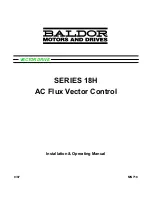
August 2020
|
Solar Stik
®
, Inc.
18
|
24VDC PRO-Verter 7000-120 AGS Operator Manual
INPUT (FAVS 03) setting should be set to the same value of the maximum AC power output rating
of the source. For example, if the generator is rated for 3000 Watts continuous output, then the AC
INPUT should be set for 25 Amps for @ 120 VAC or 13.6 A @ 220 VAC (=3000 Watts).
“Pass-through” Power and the Internal AC Transfer Switch
The PRO-Verter employs a high-speed transfer switch that enables it to toggle between incoming AC
power when it is available (i.e. when the generator is on or it is connected to grid-utility power) and
Inverter power when necessary (using energy from the batteries).
When AC power is available at the PRO-Verter’s AC input, it is first “qualified” by the PRO-Verter to
make sure it is acceptable (i.e. within the programmed limits of quality) to pass on to a connected
load, and once it has been qualified (approximately 15 seconds in duration), the switch engages
and incoming AC power is transferred directly to the load. The PRO-Verter is designed to ensure
that the load is always supported FIRST before it does anything else with the incoming power (Load
Prioritization).
The primary benefit of using a transfer switch is simple: it maximizes the efficiency of the system while
keeping constant power to the load:
• If the PRO-Verter is controlling a generator, the transfer switch allows it to maximize the load
on the generator (for optimal engine operation), and it also ensures that the all of the fuel (i.e.
“energy”) consumed in the generator engine is utilized - for direct load support and/or to charge a
connected battery bank (storing energy for later use).
• If the PRO-Verter is being used with grid-utility power, the transfer switch allows the PRO-Verter to
control multiple conditions under which power is harvested, including time-of-day, peak-shaving,
or other condition based on application requirements.
The transfer switch is directly controlled by the inverter function, but it ONLY reacts to the presence
of incoming AC power from a generator or grid-utility. The switch ensures that the AC output of the
PRO-Verter is always active, whether the PRO-Verter is inverting or passing power through from an
external source (generator or grid).
If inverter function is engaged, the transfer switch is also engaged. The transfer switch is disabled if
the Inverter function is off.
Transfer time between incoming AC and Inverter mode is ~16ms when using 60Hz, which is usually
fast enough to support computers, servers, and other critical loads, however, the “effective” transfer
switch time may be prolonged if the frequency is lower (i.e., 50Hz) and/or if the VAC DROPOUT
(Charger Setup menu) is set too low for the loads to be sustained (the voltage drops below a load’s
minimum voltage requirement AND the transfer switch causes an interruption in AC to the load.
When using the PRO-Verter with critical loads, the VAC DROPOUT should be set to UPS MODE. The
disadvantage of a higher VAC Dropout setting is that smaller generators (or large generators with an
unstable output) may nuisance transfer. This happens commonly when powering loads that are larger
than the generator can handle—causing the generator’s output voltage to constantly fall below the
inverter’s input VAC dropout threshold.
Note:
When switching from Inverter mode to Standby mode, the PRO-Verter waits approximately
15 seconds as it qualifies the incoming AC, ensuring the AC source is clean and stable before
transferring the load.
















































